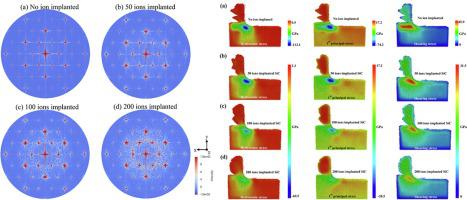Computational Materials Science ( IF 3.3 ) Pub Date : 2021-09-04 , DOI: 10.1016/j.commatsci.2021.110837 Yexin Fan 1 , Zongwei Xu 1 , Ying Song 1 , Bing Dong 1 , Zhifu Xue 1 , Bing Liu 2 , Lei Liu 1 , Dongyu Tian 1

|
As a third-generation semiconductor material, four-hexagonal silicon carbide (4H-SiC) finds wide application in industries. The high efficiency and performance machining of 4H-SiC ceramics have attracted researchers’ more attention. Ultra-precision diamond cutting is generally used to machine high-quality nanoscale surfaces. As a typical hard-to-cut brittle material, 4H-SiC causes significant tool wear during machining. It is necessary to study the effective process parameters and machining methods to improve the machining performance. In this study, the molecular dynamic (MD) analysis was used to comparatively investigate the effect of 4H-SiC by implanted different Ga ion implantation doses. The lattice damage, hydrostatic stress, radial distribution function (RDF), and selected area electron diffraction (SAED) were analyzed in detail. The cutting effect of implanted 4H-SiC with different implantation ions was then compared with unimplanted 4H-SiC. The machining properties were characterized by removed material morphological structure, temperature, coordination number, and stress distribution. The results provided an understanding of the mechanism of ion implantation-assisted nano-cutting. Besides, the effect of ion implantation-assisted and stress-assisted combined nano-cutting 4H-SiC was also investigated. The results demonstrated that the combination of ion implantation-assisted and stress-assisted could effectively decrease the cutting force and stresses, thus improving the machining efficiency and machinability of 4H-SiC.
中文翻译:

离子注入辅助加工中4H-SiC纳米材料去除机理
四六方碳化硅(4H-SiC)作为第三代半导体材料,在工业上有着广泛的应用。4H-SiC陶瓷的高效率和高性能加工引起了研究人员的更多关注。超精密金刚石切割通常用于加工高质量的纳米级表面。作为一种典型的难切削脆性材料,4H-SiC 在加工过程中会导致显着的刀具磨损。有必要研究有效的工艺参数和加工方法,以提高加工性能。在本研究中,分子动力学 (MD) 分析用于比较研究 4H-SiC 注入不同 Ga 离子注入剂量的影响。详细分析了晶格损伤、静水应力、径向分布函数(RDF)和选区电子衍射(SAED)。然后将具有不同注入离子的注入 4H-SiC 的切割效果与未注入的 4H-SiC 进行比较。通过去除材料的形态结构、温度、配位数和应力分布来表征加工性能。结果提供了对离子注入辅助纳米切割机制的理解。此外,还研究了离子注入辅助和应力辅助联合纳米切割 4H-SiC 的效果。结果表明,离子注入辅助和应力辅助相结合可以有效降低切削力和应力,从而提高4H-SiC的加工效率和可加工性。通过去除材料的形态结构、温度、配位数和应力分布来表征加工性能。结果提供了对离子注入辅助纳米切割机制的理解。此外,还研究了离子注入辅助和应力辅助联合纳米切割 4H-SiC 的效果。结果表明,离子注入辅助和应力辅助相结合可以有效降低切削力和应力,从而提高4H-SiC的加工效率和可加工性。通过去除材料的形态结构、温度、配位数和应力分布来表征加工性能。结果提供了对离子注入辅助纳米切割机制的理解。此外,还研究了离子注入辅助和应力辅助联合纳米切割 4H-SiC 的效果。结果表明,离子注入辅助和应力辅助相结合可以有效降低切削力和应力,从而提高4H-SiC的加工效率和可加工性。还研究了离子注入辅助和应力辅助组合纳米切割 4H-SiC 的效果。结果表明,离子注入辅助和应力辅助相结合可以有效降低切削力和应力,从而提高4H-SiC的加工效率和可加工性。还研究了离子注入辅助和应力辅助组合纳米切割 4H-SiC 的效果。结果表明,离子注入辅助和应力辅助相结合可以有效降低切削力和应力,从而提高4H-SiC的加工效率和可加工性。



























 京公网安备 11010802027423号
京公网安备 11010802027423号